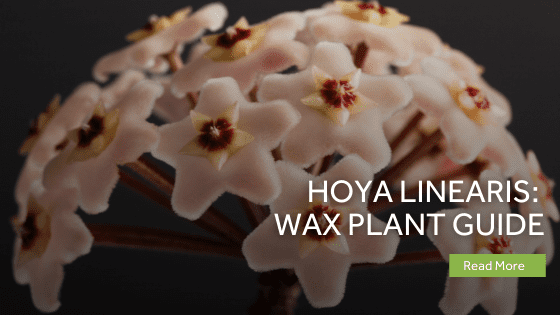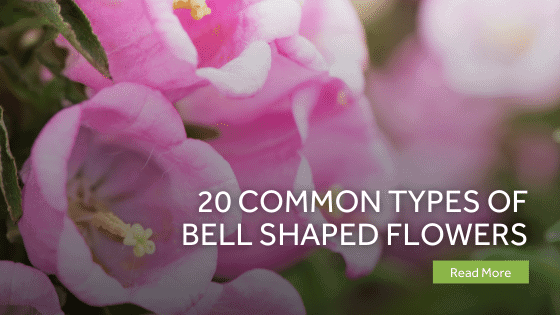The Hoya linearis plant, commonly known as the Wax Plant, Wax Vine, and the Porcelain Vine, is a popular ornamental plant grown in homes and gardens worldwide. Some people find Hoyas relatively easy to grow, while others have difficulty with them. Find out more about this one of the Hoya species in this article.
Table of Contents
Hoya linearis Overview
Hoya plants are succulent-like from the Apocynaceae family of the Asclepiadaceae order, a large plant family with over 500 genera and more than 8,000 species. The Hoya genus itself contains about 200 flowering species and 65 non-flowering species.
Hoya linearis is a long plant native of Southeast Asia and Australasia. It grows in the wild in countries such as Indonesia, the Philippines, Papua New Guinea, and Australia.
Hoya linearis is commonly known as Wax plant or Waxflower. However, it also goes by the name Hoya ‘carnosa’ linearis. Different cultivars have been bred for certain qualities.
| Botanical Name | Hoya Linearis |
| Family | Apocynaceae |
| Genus | Hoya |
| Origin | Southeast Asia and Australasia |
| Sunlight | Bright, filtered sunlight but not direct sunlight |
| Watering | When the top of the soil feels dry to the touch |
| Soil | Well-draining soil |
| Temperature | 50°F to 80°F |
| Propagation | Division, stem cuttings, or air layering |
| Re-Potting | Every 2 to 3 years |
| Pests and Diseases | Susceptible to pests, toxins, diseases, or other problems |
| Toxicity | Non-toxic to kids and pets |
Hoya linearis Features
Hoya linearis typically grows between 12 and 18 inches tall but can vary depending on the cultivar. Hoya Linearis are trailing houseplants and are great hanging plants.
The plant has thick, fleshy leaves that are about 1 inch wide and 3 to 5 inches long.
Hoya linearis has white, star-shaped flowers about 1 inch wide. The flowers usually bloom from late winter to early summer.
The fruit of Hoya linearis is a small capsule that contains several hairy seeds.
Related Article: Hoya Lacunosa: Caring for the Cinnamon Scented Plant
Hoya linearis Care Guide
Hoya linearis is a succulent that is relatively easy to care for. It needs well-draining soil and does best in warmer temperatures with high humidity. The plant can be grown under medium to bright light but should not be exposed to direct light.
Water Hoya linearis regularly at the base, but not the leaves or flowers. You can give the leaves just a light, occasionally misting to increase humidity. Fertilize the plant every other month with a balanced fertilizer.
Prune Hoya linearis regularly to keep it healthy and looking its best. Cut off any dead or dying leaves and branches.
Ideal Growing Place
Hoya linearis’ ideal growing location is high humidity and a warm environment with bright, indirect light.
Water
You should water your Hoya linearis when the top of the soil feels dry to the touch. Any extreme water temperatures can send the plant into shock, causing leaves to drop off. Too much water or watering to the point of soggy soil can lead to root rot.
Sunlight
The Hoya linearis requires bright, filtered sunlight but not direct sunlight. If you place this plant in direct sunlight, the leaves will burn and shrivel.
Low-light conditions are not conducive to this plant’s growth. They become bald if they do not get enough light on their tops.
Hoya linearis is a species that can tolerate cooler temperatures indoors but prefers temperatures between 50 to 80 degrees Fahrenheit.
It does well in the morning sun in winter, but you should be careful of the hot summer sun if you live in a warmer region. Too much sun or prolonged exposure can burn the foliage.
Temperature
The ideal temperature for growing Hoya linearis is between 50 and 80 degrees Fahrenheit.
This species of Hoya linearis grows in higher altitudes to endure cooler nighttime temperatures in the wild.
Houseplants need a minimum temperature of 10 degrees Celsius (50 degrees Fahrenheit) at night, the general temperature rule.
Soil
Hoya linearis does best in well-draining soil. You can use an appropriate potting mix specifically made for succulents, or you can make your own mix using 50% sand and 50% potting soil.
Humidity
Hoya linearis likes high humidity, so you should mist your plant regularly. You can also place the pot on a tray of wet pebbles. This will help to keep the humidity high around the plant.
Fertilizer
You should fertilize your Hoya linearis twice a month with a balanced fertilizer. If the potting medium is dehydrated, water lightly before feeding to avoid burning the roots. If your Hoya is about to bloom, you can use a feed with more phosphorus.
Pinching/Pruning
Hoya linearis does not need pruning often. However, you can prune it if you want to propagate new plants or if you want to shape the plant.
Potting and Re-Potting
Hoya linearis does not need to be repotted often either. You can repot it every 2 or 3 years, or when the pot becomes too small for the plant.
Growth Zone
Hoya linearis is a tropical plant doing best in USDA growth zones 10 and 11. These zones are located in the south along the coast. They thrive here due to the high humidity.
Common Pests, Toxins, Diseases & Other Problems
Mealybugs, aphids, and spider mites are the most common pests and diseases of the Hoya linearis.
If you notice any pests or diseases on your plant, treat it with an appropriate pesticide, fungicide, or insecticide.
There are many types available, so be sure to read the label to ensure you are using the correct product. Also, because they can be toxic to plants and pets, always be sure to follow the manufacturer’s instructions carefully.
You can also create your own solution with 1 cup of alcohol and 1 quart of water. Then, use a spray bottle to spray the solution on the leaves.
Hoya linearis Propagation
Hoya linearis can be propagated by division, stem cuttings, or air layering.
Division is the easiest way to propagate this plant. You can divide a clump of your plant into several individual plants by gently digging them up and separating them.
Stem cuttings can be taken in late spring or early summer during the growing season. Cut a 3-inch section of stem from the mother plant and remove the leaves from the lower half of the cutting. Dip the cutting in a rooting hormone and place it in a moist potting soil. Keep the soil moist and place the cutting in a bright, warm location.
Air layering is done by removing a small section of bark from the plant’s stem and covering it with rooting hormones. Next, wrap the area with moist sphagnum moss and secure it with twist ties. Once the roots are well-developed, cut the stem below the air layer and transplant the new plant into potting soil.
Related Article: Hoya Pubicalyx: The Ultimate Care Guide
Linearis Hoya Mature Timeline
The mature timeline for a Hoya linearis is about two to three years. During this time, the plant will grow steadily and produce flowers.
The first year of growth is the most important, as it is when the plant establishes its root system. After the first year, the plant can be moved to a larger pot or a location with more sunlight.
The Hoya linearis will reach maturity and begin blooming in its third year. It will continue to bloom every year after that.
The mature plant can grow up to 18 inches tall and will have a spread of about 12 inches.
Hoya retusa vs linearis
The two species of hoya plants, retusa, and linearis, are very similar in appearance. They are both vines that grow quickly and have thick, green leaves. They both produce fragrant flowers that come in a variety of colors.
The main difference between the two plants is their growth habit. Hoya retusa is a trailing plant, while Hoya linearis is a climbing plant.
Hoya linearis also has a more upright growth habit than Hoya retusa.
Both plants are easy to care for and can be grown in various climates.
Linearis Hoya FAQ
Is Hoya Linearis Rare?
Yes, Hoya linearis is a rare plant popular among gardeners and home growers.
Is Hoya Linearis Toxic to Dogs, Cats, and Humans?
Yes and no. While the Hoya linearis is non-toxic, it is hard to digest due to its white latex or milky sap. As a result, it can cause pain and discomfort if ingested.
Does the Hoya Linearis Flower?
Yes. Depending on the growing conditions, it can take 2 to 5 years for the plant to reach maturity but grows small white flowers that sometimes have a pink hue.
How Fast Does Hoya Linearis Grow?
Hoya linearis grows at a medium rate. It can grow 1 to 2 inches per year, depending on the growing conditions.
Where Can I Buy Hoya Linearis?
Hoya linearis is available at most garden centers and online nurseries. You can also find it at some home improvement stores.
Is Hoya Linearis Hard to Grow?
No, Hoya linearis is a hardy plant that is easy to grow. It does best in well-draining soil and does not require a lot of sunlight but will struggle with not enough humidity.
Is Hoya Linearis a Succulent?
No, Hoya linearis is not a succulent, but its leaves are succulent-like. It is a tropical plant that does best in moist soil and high humidity.
Is Hoya Linearis the Same as String of Needles?
No, the String of Needles is succulent, while the Hoya linearis is tropical. Therefore, the two plants are not related.
Why Is My Hoya Linearis Is Not Blooming?
The Hoya linearis will not bloom until it is mature. Depending on the growing conditions, it can take 2 to 5 years for the plant to reach maturity.
Why Does My Hoya Linearis Have Black Tips?
The black tips on the Hoya linearis are normal. They are caused by a natural pigment in the plant and are not harmful.
The Bottom Line
Hoya linearis is a beautiful plant that is easy to care for. It does best in well-draining soil and does not require a lot of sunlight or humidity. It can be grown in various climates and will reach maturity in 2 to 3 years and bloom every year afterward.
If you are looking for an easy-to-care-for vine, the Hoya linearis is a great option. Try growing it in your home or garden today. You won’t be disappointed!
Last Updated on August 31, 2022 by Gustaf Johansson




